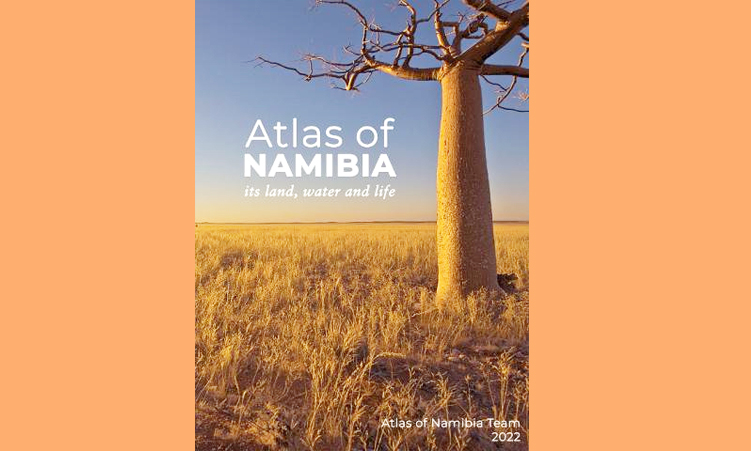It is highly unusual for a reviewer to get stuck while reviewing a book.
Getting stuck? Yes, getting stuck because the object of one’s review is just perfect.
A seasoned reviewer will always try to put a critical angle to a review, to contextualise the publication under review and to in a fault-finding way say something about it within the broader confines of, in this case, Namibian social science research.
Yet this tome – and a tome it is indeed at 33cm x 24,5cm and weighing three kilograms – can only be recommended, unreservedly, and this review cannot but be exceptionally laudatory.
Indeed, as one with a knowledge of the history of this book and its makers could have expected, this new version of ‘Atlas of Namibia: Its Land, Water and Life’ (publisher: Namibia Nature Foundation) is not only an excellent example of Namibian publishing.
Being the second iteration of an atlas of Namibia – a first ‘Atlas of Namibia: A Portrait of the Land and its People’ was produced in 2002 with a second impression in 2003 under the tutelage of John Mendelsohn – this time around the atlas was authored, in a gesture of collegial, authorial generosity, by the Atlas of Namibia Team 2022.
Page vii has all the authors and contributors listed. Unsurprisingly maybe, the project management was in the hands of Mendelsohn and his son Martin.
Therefore, this author expected nothing but the best, and was not on any count disappointed.
This rave needs to be qualified!
What strikes the most is the balanced collectedness of the volume. The authors and contributors achieved a remarkable synthesis of what is known about Namibia in its ‘physicality’.
Kudos! The massive amounts of research conducted and literature consumed and consolidated by the authors are immensely impressive – even more so the systematic integration of this into coherent text.
That is no small feat, given the often-squabbling posture among Namibian social scientists, and one can imagine quite a few to be in the sulks.
The conversion of large amounts of statistical information – rainfall, borehole yields, relief profiles, climate dates, land use, toilet availability, to name just a few – into maps, diagrams, time and pie charts makes it accessible, even tangible without any simplification.
As such, the book is dangerous because once you start engaging with it, it draws you in, and without you noticing, you have forgotten the world around you.
The atlas is richly illustrated with high-quality photographs, thus providing visual pleasure abundantly, and one is quite tempted to peruse it in its visuality exclusively.
This, again, is quite an accomplishment, as arguably one could learn extensively about Namibia by only looking at the images and their captions.
On the same count, the atlas also helps in taking a position with some sense of certainty, when it comes to the many puzzling and yet unexplained features of Namibia, in particular its geology.
The creation of Gondwana is coherently explained and leaves one with a sense of intellectual accomplishment – both of the authors and oneself, as one has finally comprehended a difficult subject.
Resulting from all this, this reviewer’s take on Namibia’s landscapes and manscapes, his understanding of its geological history and human geography has been enhanced substantially.
A totally new understanding of natural processes, of relevant features and facts has indeed resulted in a far more nuanced appreciation of, and at the same time a far more organic and complete grasp, of the totality of what comprises Namibia.
A hitherto unknown feeling of being a physical part of Namibia has grown. One can, arguably, consider the book to be a very important contribution to Namibian nation building, therefore, as the book has the potential to get one to identify with one’s surroundings on quite a visceral level.
Of course the book’s production would not have been possible without generous funding from non-governmental organisations, in particular Germany’s Gesellschaft für Internationale Zusammenarbeit as the source of most funds.
Sadly, this did not make the hard copy of the book affordable, but one does not really want to think what the book would cost without this assistance.
However, the book is available at https://www.atlasofnamibia.online.
There, the entire book or selected chapters can be downloaded for free, as well as individual maps and all the data used to compile the maps.
These resources are made available in the hope that students, technicians and scientists will make abundant use of them to advance our knowledge and understanding of Namibia.
Indeed, that is central to the purpose of the ‘Atlas of Namibia’!
- Wolfram Hartmann is a Namibian historian, author and independent scholar. Reach him at drw@orumbonde.com
Stay informed with The Namibian – your source for credible journalism. Get in-depth reporting and opinions for
only N$85 a month. Invest in journalism, invest in democracy –
Subscribe Now!






